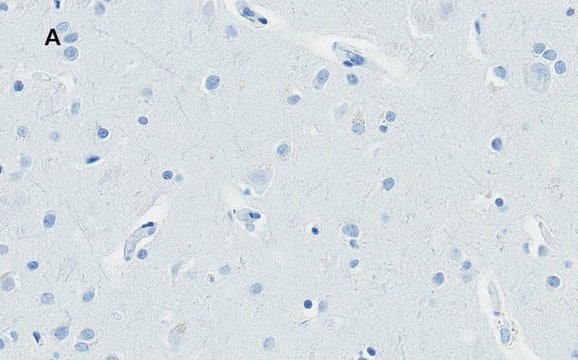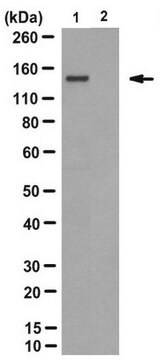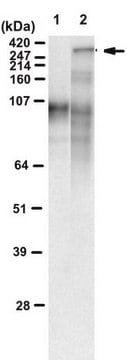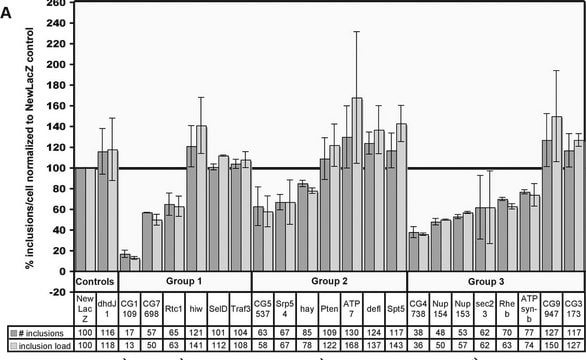Typically, a minimum of 3-6 amino acids is used to generate an antibody. Peptides that are 10-20 amino acids long are considered ideal for antibody preparation, while those used for structure/function studies can vary in length. In the literature, the N-terminal fragments of Huntingtin in the cortex have been fully characterized. The second protease-susceptible domain, known as the “B” domain, is expected to be located farther from the N-terminal and in proximity to the region corresponding to residues 181–810. This sequence is utilized to validate the specificity of the antibody.
MAB2166
Anti-Huntingtin Disease (HD/HTT) Antibody
CHEMICON®, mouse monoclonal, 1HU-4C8
Synonim(y):
Huntingtin, Huntington′s Disease Protein, HD Protein
Wybierz wielkość
3760,00 zł
Przewidywany termin wysyłki23 kwietnia 2025Szczegóły
Wybierz wielkość
About This Item
3760,00 zł
Przewidywany termin wysyłki23 kwietnia 2025Szczegóły
Polecane produkty
Nazwa produktu
Anti-Huntingtin Protein Antibody, a.a. 181-810, clone 1HU-4C8, ascites fluid, clone 1HU-4C8, Chemicon®
pochodzenie biologiczne
mouse
Poziom jakości
forma przeciwciała
ascites fluid
rodzaj przeciwciała
primary antibodies
klon
1HU-4C8, monoclonal
reaktywność gatunkowa
rat, rabbit
reaktywność gatunkowa (przewidywana na podstawie homologii)
mouse, human, hamster, monkey
producent / nazwa handlowa
Chemicon®
metody
ELISA: suitable
immunocytochemistry: suitable
immunohistochemistry: suitable (paraffin)
immunoprecipitation (IP): suitable
western blot: suitable
izotyp
IgG1κ
numer dostępu NCBI
numer dostępu UniProt
Warunki transportu
dry ice
docelowa modyfikacja potranslacyjna
unmodified
informacje o genach
human ... HTT(3064) , SLC6A4(6532)
Opis ogólny
Specyficzność
Immunogen
Zastosowanie
A 1:500-1:5,000 dilution of a previous lot was used on ELISA.
Immunohistochemistry:
A 1:500-1:5,000 dilution from a previous lot was used on frozen and microwave oven treated paraffin sections (human tissue).
Immunocytochemistry:
1:500-1:5,000 on a previous lot was used on transfected cells.
Immunoprecipitation:
A 1:500-1:5,000 dilution of a previous lot was used on immunoprecipitation.
Western blot:
1:500-1:5,000. Should detect a band migrating at approximately 350-400 kDa by Western blot (Nature Genetics 10:104-110.).
Optimal working dilutions must be determined by the end user.
Neuroscience
Neurodegenerative Diseases
Jakość
Western Blot Analysis:
1:1000 dilution of this lot detected huntingtin protein on 10 μg of rat brain lysates.
Opis wartości docelowych
Postać fizyczna
Przechowywanie i stabilność
Handling Recommendations: Upon receipt, and prior to removing the cap, centrifuge the vial and gently mix the solution. Aliquot into microcentrifuge tubes and store at -20°C. Avoid repeated freeze/thaw cycles, which may damage IgG and affect product performance.
Komentarz do analizy
Normal human cerebral cortex lysate
Inne uwagi
Informacje prawne
Oświadczenie o zrzeczeniu się odpowiedzialności
Nie możesz znaleźć właściwego produktu?
Wypróbuj nasz Narzędzie selektora produktów.
polecane
Kod klasy składowania
12 - Non Combustible Liquids
Klasa zagrożenia wodnego (WGK)
WGK 2
Temperatura zapłonu (°F)
Not applicable
Temperatura zapłonu (°C)
Not applicable
Certyfikaty analizy (CoA)
Poszukaj Certyfikaty analizy (CoA), wpisując numer partii/serii produktów. Numery serii i partii można znaleźć na etykiecie produktu po słowach „seria” lub „partia”.
Masz już ten produkt?
Dokumenty związane z niedawno zakupionymi produktami zostały zamieszczone w Bibliotece dokumentów.
Klienci oglądali również te produkty
Produkty
Immunofluorescencja wykorzystuje cząsteczki fluorescencyjne sprzężone z przeciwciałami do lokalizacji białek, potwierdzania modyfikacji i wizualizacji kompleksów białkowych.
Immunofluorescence uses antibody-conjugated fluorescent molecules for protein localization, modification confirmation, and protein complex visualization.
Protokoły
Tips and troubleshooting for FFPE and frozen tissue immunohistochemistry (IHC) protocols using both brightfield analysis of chromogenic detection and fluorescent microscopy.
-
Is the epitope binding site for the MAB2166 antibody to Huntingtin, spanning AA 181 to 810, considered a wide range for binding due to the protein's confirmation that enables the antibody to bind these two sites?
1 answer-
Helpful?
-
Active Filters
Nasz zespół naukowców ma doświadczenie we wszystkich obszarach badań, w tym w naukach przyrodniczych, materiałoznawstwie, syntezie chemicznej, chromatografii, analityce i wielu innych dziedzinach.
Skontaktuj się z zespołem ds. pomocy technicznej









